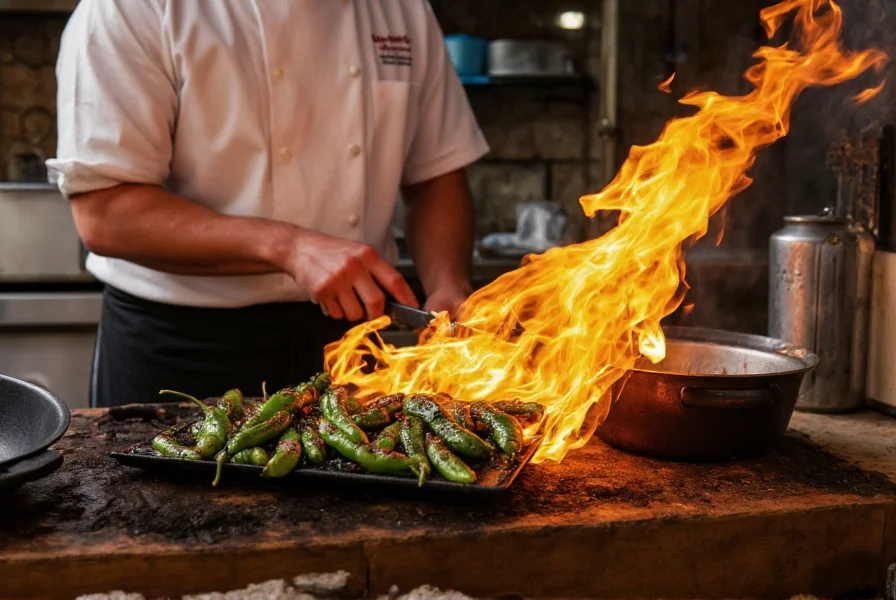Understanding poblano chili spiciness helps home cooks and chefs leverage this versatile pepper effectively. While classified as a mild chili, poblano heat can vary based on growing conditions, ripeness, and individual plant genetics. This comprehensive guide examines poblano pepper characteristics, heat comparisons, and practical culinary applications.
What Makes Poblanos Mildly Spicy?
Poblanos ( Capsicum annuum) originate from Puebla, Mexico, and rank low on the Scoville scale due to minimal capsaicin concentration. The white pith and seeds contain most heat compounds, but even when included, poblanos rarely cause significant burning sensations. Unlike habaneros or ghost peppers, poblano chilis deliver subtle warmth that complements rather than dominates dishes.
Poblano Heat Level Compared to Common Peppers
| Pepper Variety | Scoville Heat Units (SHU) | Heat Comparison to Poblano |
|---|---|---|
| Poblano (fresh) | 1,000-2,000 | Baseline |
| Bell Pepper | 0 | 0-50% milder |
| Anaheim Pepper | 500-2,500 | Similar or slightly milder |
| Jalapeño | 2,500-8,000 | 2-4x hotter |
| Serrano | 10,000-23,000 | 5-10x hotter |
This poblano chili spicy comparison shows why they're preferred for dishes requiring subtle heat. When roasted and dried, poblanos become ancho chilis with slightly concentrated heat (1,000-3,000 SHU) while developing rich, raisin-like flavors.
Factors Affecting Poblano Pepper Heat
Several elements influence poblano spiciness levels:
- Ripeness: Green poblanos are milder; red-ripe versions develop slightly more heat and sweetness
- Growing conditions: Stress from drought or poor soil increases capsaicin production
- Individual variation: Heat can differ between peppers on the same plant
- Preparation method: Removing seeds and membranes reduces heat by 60-70%
Culinary Applications for Mild Heat
Chefs value poblano peppers for their thick walls and manageable heat. Common uses include:
- Stuffed poblano peppers (chiles rellenos) with cheese or meat fillings
- Base for Mexican mole sauces where heat shouldn't overpower complex flavors
- Roasted and blended into salsas for subtle warmth
- Dried as anchos for smoky-sweet applications
When substituting poblano for hotter peppers, use 1.5-2x the quantity. For poblano alternatives, Anaheim peppers offer similar mild heat, while cubanelles provide even less spice.
Safety Tips for Handling Poblanos
Despite their mild classification, follow these precautions:
- Wear gloves when handling multiple peppers or if you have sensitive skin
- Avoid touching eyes or face during preparation
- Rinse cutting boards and knives thoroughly after use
- Remove seeds and white ribs to minimize heat in sensitive dishes
Contrary to popular belief, adding dairy doesn't neutralize capsaicin immediately—it merely coats the tongue. For immediate relief, try sugar or honey before dairy products.
Common Misconceptions About Poblano Heat
Several myths persist about poblano chili spiciness:
- Myth: All poblanos are equally mild
- Reality: Heat varies significantly between plants and growing seasons
- Myth: Roasting increases heat
- Reality: Roasting caramelizes sugars but doesn't increase SHU ratings
- Myth: Poblanos can't cause burning sensations
- Reality: Sensitive individuals may still experience mild discomfort
When Poblanos Surprise with Extra Heat
Occasionally, poblano peppers exceed their typical heat range due to:
- Cross-pollination with hotter pepper varieties
- Extended time on the vine past optimal harvest
- Genetic mutations in commercial seed stock
If you encounter unexpectedly hot poblanos, reduce heat by:
- Soaking sliced peppers in vinegar for 10-15 minutes
- Cooking with acidic ingredients like tomatoes or citrus
- Balancing with sweet elements like corn or roasted squash

Conclusion
Poblano peppers occupy the perfect middle ground for those seeking mild chili heat with robust flavor. Their 1,000-2,000 SHU rating makes them accessible to most palates while still providing the characteristic warmth associated with authentic Mexican cuisine. Understanding poblano chili spicy characteristics allows cooks to confidently incorporate them into diverse dishes without fear of overwhelming heat.
Are poblano peppers hotter when ripe?
Ripe red poblanos develop slightly more heat (up to 3,000 SHU) than green versions, but the difference is minimal. The primary change is enhanced sweetness and fruitiness as they mature.
Can I substitute poblano for jalapeño in recipes?
Yes, but use 1.5-2 poblano peppers for each jalapeño required. Remember that poblanos have thicker walls and different flavor profiles, so adjust cooking times accordingly.
Why are some poblano peppers spicier than others?
Environmental stressors like drought, temperature fluctuations, and soil conditions cause natural variation in capsaicin production. Individual peppers on the same plant can also differ significantly in heat intensity.
How to reduce poblano pepper heat without losing flavor?
Remove all seeds and white membranes (placenta), which contain 80% of the capsaicin. Soaking sliced peppers in salted water for 15 minutes further reduces heat while preserving flavor compounds.
Do dried poblano peppers (anchos) have more heat?
Drying concentrates flavors but doesn't significantly increase heat. Ancho chilis range from 1,000-3,000 SHU—slightly higher than fresh poblanos due to moisture removal, but still considered mild.











 浙公网安备
33010002000092号
浙公网安备
33010002000092号 浙B2-20120091-4
浙B2-20120091-4